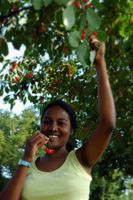| Thursday, July 12, 2007 |
|
|
posted by Daryl @ 2:09 PM  |
|
|
|
| Saturday, June 02, 2007 |
| Anoushka is growing... |
 |
posted by Daryl @ 12:36 PM  |
|
|
|
| Monday, May 07, 2007 |
| Car Boot sale |
Johannie's stand at the Bracknell Car Boot Sale....JPG) |
posted by Daryl @ 2:19 AM  |
|
|
|
| Tuesday, April 10, 2007 |
| Happy Birthday, Johannie ! |
 |
posted by Daryl @ 11:05 AM  |
|
|
|
| Monday, March 19, 2007 |
| back in the lab ! |
I'm back in the lab, and it's much closer than going to London each day ! |
posted by Daryl @ 5:05 AM  |
|
|
|
| Saturday, March 10, 2007 |
| Johannie's publication in the American Journal of Human Genetics |
| Am J Hum Genet. 2006 Aug ;79 (2):323-31 16826522 |
| | Linkage Analysis Using Co-Phenotypes in the BRIGHT Study Reveals Novel Potential Susceptibility Loci for Hypertension. | | [My paper] Chris Wallace , Ming-Zhan Xue , Stephen J Newhouse , Ana Carolina B Marcano , Abiodun K Onipinla , Beverley Burke , Johannie Gungadoo , Richard J Dobson , Morris Brown , John M Connell , Anna Dominiczak , G Mark Lathrop , John Webster , Martin Farrall , Charles Mein , Nilesh J Samani , Mark J Caulfield , David G Clayton , Patricia B Munroe | | Identification of the genetic influences on human essential hypertension and other complex diseases has proved difficult, partly because of genetic heterogeneity. In many complex-trait resources, additional phenotypic data have been collected, allowing comorbid intermediary phenotypes to be used to characterize more genetically homogeneous subsets. The traditional approach to analyzing covariate-defined subsets has typically depended on researchers' previous expectations for definition of a comorbid subset and leads to smaller data sets, with a concomitant attrition in power. An alternative is to test for dependence between genetic sharing and covariates across the entire data set. This approach offers the advantage of exploiting the full data set and could be widely applied to complex-trait genome scans. However, existing maximum-likelihood methods can be prohibitively computationally expensive, especially since permutation is often required to determine significance. We developed a less computationally intensive score test and applied it to biometric and biochemical covariate data, from 2,044 sibling pairs with severe hypertension, collected by the British Genetics of Hypertension (BRIGHT) study. We found genomewide-significant evidence for linkage with hypertension and several related covariates. The strongest signals were with leaner-body-mass measures on chromosome 20q (maximum LOD=4.24) and with parameters of renal function on chromosome 5p (maximum LOD=3.71). After correction for the multiple traits and genetic locations studied, our global genomewide P value was .046. This is the first identity-by-descent regression analysis of hypertension to our knowledge, and it demonstrates the value of this approach for the incorporation of additional phenotypic information in genetic studies of complex traits. |
| Hypertension. 2006 Jun 5; : 16754790 |
| | Increased Support for Linkage of a Novel Locus on Chromosome 5q13 for Essential Hypertension in the British Genetics of Hypertension Study. | | [My paper] Patricia B Munroe , Chris Wallace , Ming-Zhan Xue , Ana Carolina B Marçano , Richard J Dobson , Abiodun K Onipinla , Beverley Burke , Johannie Gungadoo , Stephen J Newhouse , Janine Pembroke , Morris Brown , Anna F Dominiczak , Nilesh J Samani , Mark Lathrop , John Connell , John Webster , David Clayton , Martin Farrall , Charles A Mein , Mark Caulfield | Human hypertension arises from a combination of genetic factors and lifestyle influences. With cardiovascular disease set to become the number 1 cause of death worldwide, it is important to understand the etiologic mechanisms for hypertension, because these might provide new routes to improved treatment. The British Genetics of Hypertension Study has recently published a primary genome screen that identified 4 chromosomal regions of interest. We have now genotyped additional markers to confirm the most promising regions for follow-up studies. Thirty-four additional microsatellites were genotyped in our severely hypertensive affected sibling pair resource (now 1635 families with 2142 affected sibling pairs), leading to a substantial increase in information content in the regions of interest. We found increased support for linkage of chromosome 5q13 to human hypertension (multipoint logarithm of odds=2.50) with 3 adjacent markers yielding single point logarithm of odds scores of 3.22, 2.84, and 2.51. The placement of additional markers on 2q, 6q, and 9q diminished support for linkage in these regions. However, the addition of new data and families identified novel regions of interest on chromosomes 1q and 11q. The 3 positive markers in the chromosome 5 region were also genotyped in 712 distinct parent-offspring trios with the same severe phenotype to replicate linkage and association. Borderline support for replication was found (P=0.07). We found increased evidence for linkage and borderline-significant evidence for association for a hypertension susceptibility locus on chromosome 5q13 that is worthy of detailed fine mapping and assessment of candidate genes.
Also, see the article in the American Heart Association Journal: http://hyper.ahajournals.org/cgi/content/full/48/1/105
And the Oxford Journal of Human Molecular Genetics:
http://hmg.oxfordjournals.org/cgi/content/abstract/13/suppl_1/R169
And the John Hopkins University (OMIM database):
http://www.ncbi.nlm.nih.gov/entrez/dispomim.cgi?id=610262
And the Centre National de Génotypage:
http://www.cng.fr/en/publications/pub2006.html
And the New England Journal of Medecine:
http://content.nejm.org/cgi/content/abstract/336/16/1117
And NCBI / PubMed: http://www.ncbi.nlm.nih.gov/entrez/query.fcgi?cmd=search&db=pubmed&term=Webster+J[au]&dispmax=50
And the University de Catalunya (Spain):
http://sumaris.cbuc.es/cgis/sumari.cgi?issn=0194911X&idsumari=A2006N000001V000048
|
|
posted by Daryl @ 1:15 PM  |
|
|
|
| Sunday, July 02, 2006 |
|

Cherry picking, today ! |
posted by Daryl @ 2:05 PM  |
|
|
|
|
|

Johannie finds regreshment in a cool watermelon, on a hot summer day |
posted by Daryl @ 6:29 AM  |
|
|
|
|
| About Me |
|

Name: Daryl
Home: Bracknell, Berkshire, United Kingdom
About Me: Johannie is a Scientist (Molecular Biology) and Daryl is an Engineer (Electronics)
See my complete profile
|
| Previous Post |
|
| Archives |
|
|
| Links |
|
|
| Template by |

|
|

